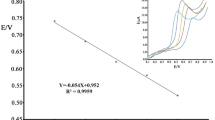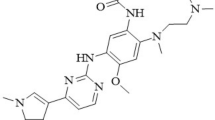Abstract
Bortezomib (BTZ) and dasatinib (DA) are two substantial anti-cancer agents with side effects on the human body. In this research, we fabricated a novel electrochemical sensor modified by CuFe2O4/SmVO4 nanocomposite and 1-ethyl-3-methylimidazolium chloride (1E3MC) as an ionic liquid (IL) (CuFe2O4/SmVO4/IL/CPE) for coinciding investigation of BTZ and DA for the first time. The CuFe2O4/SmVO4 synthesized were determined and certified through field-emission scanning electron microscopy (FE-SEM), energy diffraction X-ray (EDX), and X-ray diffraction (XRD). The capability of the sensor was investigated by different electrochemical techniques such as cyclic voltammetry (CV), chronoamperometry (CHA), differential pulse voltammetry (DPV), and electrochemical impedance spectroscopy (EIS). The attained data showed that the oxidation signal of bortezomib and dasatinib promoted as an innovative electrochemical sensor. After optimization of the conditions using this sensor at pH 7.0, the oxidation signal of bortezomib and dasatinib showed to be linear with drug concentrations in the range of 0.09–90 µM and 100–500 µM with a detection limit of 5.4 nM and 7.0 µM, respectively, using differential pulse voltammetry method. The values of D and electro-transfer coefficient (α) achieved 2.5 × 10−5 cm2 s−1 and 0.99, respectively. The proposed electrochemical sensor exhibited acceptable selectivity and sensitivity for simultaneous detection of bortezomib and dasatinib in pharmaceutical and biological samples.










Similar content being viewed by others
Data availability
The datasets generated and analyzed during the current study are available from the corresponding author on reasonable request.
References
Nunes AT, Annunziata CM (2017) Proteasome inhibitors: structure and function. Semin Oncol 44:377–380. https://doi.org/10.1053/j.seminoncol.2018.01.004
Citrin R, Foster JB, Teachey DT (2016) The role of proteasome inhibition in the treatment of malignant and non-malignant hematologic disorders. Expert Rev Hematol 9:873–889. https://doi.org/10.1080/17474086.2016.1216311
Hasinoff BB, Patel D, Wu X (2017) Molecular mechanisms of the cardiotoxicity of the proteasomal-targeted drugs bortezomib and carfilzomib. Cardiovasc Toxicol 17:237–250. https://doi.org/10.1007/s12012-016-9378-7
Tabchi S, Nair R, Kunacheewa C, Patel KK, Lee HC, Thomas SK, Amini B, Ahmed S, Mehta RS, Bashir Q (2019) Retrospective review of the use of high-dose cyclophosphamide, bortezomib, doxorubicin, and dexamethasone for the treatment of multiple myeloma and plasma cell leukemia. Clin Lymphoma Myeloma Leuk 19:560–569. https://doi.org/10.1016/j.clml.2019.05.001
Celesia A, Fiore T, Di Liberto D, Giuliano M, Pellerito C, Emanuele S (2022) Bortezomib potentiates the antitumor effect of tributyltin (IV) ferulate in colon cancer cells exacerbating ER stress and promoting apoptosis. Inorg Chim Acta 537:120929
Cengiz Seval G, Beksac M (2018) The safety of bortezomib for the treatment of multiple myeloma. Expert Opin Drug Saf 17:953–962. https://doi.org/10.1080/14740338.2018.1513487
Kubota K, Imai Y, Oh I, Ueno S, Kanda Y, Kario K (2022) Relationship between dasatinib-induced pulmonary hypertension and drug dose. Intern Med 2022:8392–8321. https://doi.org/10.2169/internalmedicine.8392-21
Samad A, Huq M, Rahman M (2022) Bioinformatics approaches identified dasatinib and bortezomib inhibit the activity of MCM7 protein as a potential treatment against human cancer. Sci Rep 12:1–16. https://doi.org/10.1038/s41598-022-05621-0
Guo Z-X, Yang F, van den Anker JN, Zheng Y, Zhao W (2021) A simplified method for bortezomib determination using dried blood spots in combination with liquid chromatography/tandem mass spectrometry. J Chromatogr B 1181:122905. https://doi.org/10.1016/j.jchromb.2021.122905
Najana SB, Bollikolla HB (2021) Determination of enantiomer impurity in Bortezomib lyo injection formulation by using normal-phase liquid chromatography. Futur J Pharm Sci 7:1–11. https://doi.org/10.1186/s43094-020-00157-4
Goel L, Das US, Gupta P, Velpandian T, Kumar L, Singh A, Luthra K, Gupta YK (2022) Development and validation of highly sensitive LC–ESI-MS/MS method for Bortezomib and its applications for plasma levels and drug content of branded and generic formulations in India. Chromatographia 85:127–135. https://doi.org/10.1007/s10337-021-04121-z
Kamalzadeh Z, Babanezhad E, Ghaffari S, Mohseni Ezhiyeh A, Mohammadnejad M, Naghibfar M, Bararjanian M, Attar H (2017) Determination of Bortezomib in API samples using HPLC: assessment of enantiomeric and diastereomeric impurities. J Chromatogr Sci 55:697–705. https://doi.org/10.1093/chromsci/bmx023
Chokshi A, Gajjar A, Bhanushali P, Desai P (2021) Quantification of antileukemic drug Dasatinib in human plasma: application of a sensitive liquid chromatographic method. J Chem Metrol. https://doi.org/10.25135/jcm.64.2108-2174
Alarjah MA, Shahin MH, Al-Azzah F, Alarjah AA, Omran ZH (2020) Concomitant analysis of dasatinib and curcuminoids in a pluronic-based nanoparticle formulation using a novel HPLC method. Chromatographia 83:1355–1370. https://doi.org/10.1007/s10337-020-03956-2
Moghaddam A, Zamani HA, Karimi-Maleh H (2021) A new electrochemical platform for dasatinib anticancer drug sensing using Fe3O4-SWCNTs/ionic liquid paste sensor. Micromachines 12:437. https://doi.org/10.3390/mi12040437
Abdelhameed AS, Hassan ES, Attwa MW, Al-Shakliah NS, Alanazi AM, AlRabiah H (2021) Simple and efficient spectroscopic-based univariate sequential methods for simultaneous quantitative analysis of vandetanib, dasatinib, and sorafenib in pharmaceutical preparations and biological fluids. Spectrochim Acta A Mol Biomol Spectrosc 260:119987. https://doi.org/10.1016/j.saa.2021.119987
Kumar N, Shetti NP, Jagannath S, Aminabhavi TM (2022) Electrochemical sensors for the detection of SARS-CoV-2 virus. Chem Eng J 430:132966. https://doi.org/10.1016/j.cej.2021.132966
Jafari-Kashi A, Rafiee-Pour H-A, Shabani-Nooshabadi M (2022) A new strategy to design label-free electrochemical biosensor for ultrasensitive diagnosis of CYFRA 21-1 as a biomarker for detection of non-small cell lung cancer. Chemosphere 301:134636. https://doi.org/10.1016/j.chemosphere.2022.134636
Karimi-Harandi M-H, Shabani-Nooshabadi M, Darabi R (2022) Simultaneous determination of citalopram and selegiline using an efficient electrochemical sensor based on ZIF-8 decorated with RGO and g-C3N4 in real samples. Anal Chim Acta 1203:339662. https://doi.org/10.1016/j.aca.2022.339662
Cetinkaya A, Kaya SI, Ozcelikay G, Atici EB, Ozkan SA (2021) A molecularly imprinted electrochemical sensor based on highly selective and an ultra-trace assay of anti-cancer drug axitinib in its dosage form and biological samples. Talanta 233:122569. https://doi.org/10.1016/j.talanta.2021.122569
Su M, Lan H, Tian L, Jiang M, Cao X, Zhu C, Yu C (2022) Ti3C2Tx-reduced graphene oxide nanocomposite-based electrochemical sensor for serotonin in human biofluids. Sens Actuators B Chem 367:132019. https://doi.org/10.1016/j.snb.2022.132019
Qian L, Durairaj S, Prins S, Chen A (2021) Nanomaterial-based electrochemical sensors and biosensors for the detection of pharmaceutical compounds. Biosens Bioelectron 175:112836. https://doi.org/10.1016/j.bios.2020.112836
Singh SK, Savoy AW (2020) Ionic liquids synthesis and applications: an overview. J Mol Liq 297:112038. https://doi.org/10.1016/j.molliq.2019.112038
Bahadori H, Majidi MR, Alipour E (2021) an electrochemical sensor for simultaneous determination of some pharmaceutical compounds using ionic liquid and Pd nanoparticles supported on porous silicon doped carbon-ceramic electrode as a renewable surface composite electrode. Microchem J 161:105724. https://doi.org/10.1016/j.microc.2020.105724
Shalali F, Cheraghi S, Taher MA (2022) A sensitive electrochemical sensor amplified with ionic liquid and N-CQD/Fe3O4 nanoparticles for detection of raloxifene in the presence of tamoxifen as two essentials anticancer drugs. Mater Chem Phys 278:125658. https://doi.org/10.1016/j.matchemphys.2021.125658
Xiang S, He X, Zheng F, Lu Q (2022) Multifunctional flexible sensors based on ionogel composed entirely of ionic liquid with long alkyl chains for enhancing mechanical properties. Chem Eng J 439:135644. https://doi.org/10.1016/j.cej.2022.135644
Hu X, Tang Y, Xia Y, Liu Y, Zhao F, Zeng B (2022) antifouling ionic liquid doped molecularly imprinted polymer-based ratiometric electrochemical sensor for highly stable and selective detection of zearalenone. Anal Chim Acta 1210:339884. https://doi.org/10.1016/j.aca.2022.339884
Umesh N, Jesila JA, Wang S-F, Govindasamy M, Alshgari RA, Ouladsmane M, Asharani I (2021) Fabrication of highly sensitive anticancer drug sensor based on heterostructured ZnO–Co3O4 capped on carbon nitride nanomaterials. Microchem J 167:106244. https://doi.org/10.1016/j.microc.2021.106244
Ghanei-Motlagh M, Taher MA (2018) A novel electrochemical sensor based on silver/halloysite nanotube/molybdenum disulfide nanocomposite for efficient nitrite sensing. Biosens Bioelectron 109:279–285. https://doi.org/10.1016/j.bios.2018.02.057
Ziaie N, Shabani-Nooshabadi M (2022) Introducing of Li2FeMn3O8/C–C3N4/IL nanocomposite for electrochemical determination of pantoprazole sodium in real samples. Chemosphere 287:132311. https://doi.org/10.1016/j.chemosphere.2021.132311
Li J, Huang X, Shi W, Jiang M, Tian L, Su M, Wu J, Liu Q, Yu C, Gu H (2021) Pt nanoparticle decorated carbon nanotubes nanocomposite-based sensing platform for the monitoring of cell-secreted dopamine. Sens Actuators B Chem 330:129311. https://doi.org/10.1016/j.snb.2020.129311
Kamalzadeh Z, Babanezhad E, Ghaffari S, Mohseni Ezhiyeh A, Mohammadnejad M, Naghibfar M, Bararjanian M, Attar H (2017) Determination of Bortezomib in API samples using HPLC: assessment of enantiomeric and diastereomeric impurities. J Chromatogr Sci 55(7):697–705. https://doi.org/10.1093/chromsci/bmx023
Andriamanana I, Gana I, Duretz B, Hulin A (2013) Simultaneous analysis of anticancer agents bortezomib, imatinib, nilotinib, dasatinib, erlotinib, lapatinib, sorafenib, sunitinib and vandetanib in human plasma using LC/MS/MS. J Chromatogr B 926:83–91. https://doi.org/10.1016/j.jchromb.2013.01.037
Acknowledgements
The authors are grateful to the University of Kashan for supporting this work.
Author information
Authors and Affiliations
Corresponding authors
Ethics declarations
Conflict of interest
The authors declare that they have no known competing financial interests or personal relationships that could have appeared to influence the work reported in this paper.
Additional information
Publisher's Note
Springer Nature remains neutral with regard to jurisdictional claims in published maps and institutional affiliations.
Rights and permissions
Springer Nature or its licensor (e.g. a society or other partner) holds exclusive rights to this article under a publishing agreement with the author(s) or other rightsholder(s); author self-archiving of the accepted manuscript version of this article is solely governed by the terms of such publishing agreement and applicable law.
About this article
Cite this article
Jafari-Kashi, A., Shabani-Nooshabadi, M. & Rafiee-Pour, HA. Determination of bortezomib and dasatinib anticancer drugs in real samples using an electrochemical sensor modified with new CuFe2O4/SmVO4/ionic liquid nanocomposite. Carbon Lett. 34, 961–969 (2024). https://doi.org/10.1007/s42823-023-00631-y
Received:
Revised:
Accepted:
Published:
Issue Date:
DOI: https://doi.org/10.1007/s42823-023-00631-y




